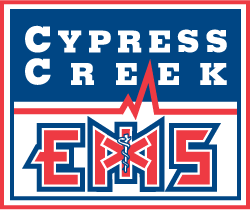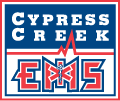CCEMS, Military Partnership Forges Forward with Firsts, Unique Approaches
By David Taylor, Houston Chronicle
When the United States Army expanded their EMS Fellowship partnership to include Cypress Creek Emergency Medical Services more than a year ago, no one could have expected the extent of the benefit to both entities, but the rare union has explored techniques and uncommon practices that have resulted in lifesaving rescues that have brought headlines for both.
Brooke Army Medical Center, or BAMC, has had an EMS Fellowship long before there was a board certification. With the influence of the previous program director and Silver Star recipient Dr. Robert Mabry, he saw that the program was combined with a Disaster Medicine Fellowship that focuses on large population emergencies, mass care, and pandemics and a Master of Public Health degree was added to the two-year program.
The Army has 400 ambulances scattered throughout its installations, but they serve a very healthy population with young soldiers, their wives, and children says Dr. Nicholas M. Studer, MD, NRP, MAJ, MC, FS, USA who is currently on rotation at Cypress Creek EMS
“A low-density population (on most installations or bases) in general is also a challenge for paramedics looking for experience,” he said in handling traumatic experiences unless they are assigned to the battlefield.
“It’s not conducive to learning what it needs to be the medical director of an EMS system and take those (practices) into the military,” he said.
Over a year ago, leadership from Cypress Creek EMS and the BAMC Fellowship director crafted an agreement to add CCEMS to their traditional rotations which at the time included San Antonio Fire Department and the Austin-Travis County EMS to gain a broader perspective on civilian EMS that could be gleaned for doctors. The benefit to CCEMS and patients served would be the low-cost access to a highly qualified physician who can act as the medical director for the program. Originally, the San Antonio Fire Department was the primary clinical site for the BAMC Fellowship but now it’s split between SAFD, Austin-Travis County EMS and Cypress Creek EMS with each of the three giving different perspectives for the trainees.
“The program costs CCEMS very little having only to invest in a response vehicle and gas, maintenance on the vehicle, and a few small supplies,” Studer said.
In return, they have a full-time doctor working with them in the field teaching and performing some lifesaving techniques that benefit the Cypress community.
The integration of military with civilian practice is becoming an increasing presence.
“You’ll see military integration where Army or Air Force ER doctors work in a civilian hospital,” he said.
The EMS Fellowship at the three sites is the only one in the military currently, making it very valuable to both partners.
Generally, SAFD can host up to two physicians per session, Cypress Creek one, and one in Austin.
Each of the three locations offers varying perspectives. SAFD is a fire department run EMS system with its own unique aspects including the presence of a union, and it’s a large agency with 46 ambulances running 24 hours every day. Austin-Travis County EMS is unique in that it’s the combination of a municipal and county system working independently of fire and police. The medical director at the EMS is also the public medical director. Cypress Creek EMS is a nonprofit ambulance company that services a large district and mostly densely, suburban related.
“It provides the experience of different EMS systems and gives us a variability in the system experience,” he said.
Cypress Creek EMS runs approximately 18 ambulances on a 24-hour shift and three peak ambulances, said CCEMS PIO Steven Beesley.
“They were the first in the country to have whole blood on a supervisory unit to bring to a scene,” the doctor said. Studer said the smaller size and flexibility of CCEMS allowed that to happen.
The expense and logistics of maintaining a large supply of whole blood on an ambulance is prohibitive and most times it can only be found on a supervisory unit.
“One of the brilliant aspects of CCEMS and the reason why they have a high care capability is they don’t try and make every single paramedic into a super-paramedic. They have a good standard for everyone, but the top achievers become supervisors and receive a fly car (one of two new Chevy Tahoes) that carry the blood,” he said.
If there are 18 ambulances carrying whole blood hoping to use them up in 28 days, it could be costly and wasteful versus the supervisory vehicle that carries two units of blood to calls that are deemed to be very ill.
About Cypress Creek EMS
Cypress Creek EMS is a 501(c)(3) non-profit organization with 46 years of excellence in emergency services formerly provided within 177 square miles of northern Harris County and to approximately 560,000 residents. CCEMS now operates in eight counties across Texas with Creek GroundCare services and around the world with Creek AirCare. CCEMS is known nationally as an innovator in prehospital medicine. For example, CCEMS was the first civilian EMS in the country to transfuse whole blood into a trauma patient in the field. CCEMS is also part of a Military EMS Fellowship that is bringing battlefield medicine to civilian EMS to reduce deaths due to trauma.
###
Contact: Miranda Sevcik 713-515-9729





